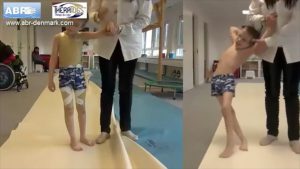For many children with quadriplegia or marked muscle weakness, one pair of hands is often not enough to help the child move well. A compressive garment is a Quick Fix.

This young boy has severe difficulty organizing his body to move. One part of this problem is that his brain is not getting accurate information about where his body is in space. However, with a snug compressive garment on his trunk, his random movements decrease and we can see that his brain is able to organize standing with minimal support and walking forward. For all of us, limbs need a stable base in order to organize movement. Watch this video clip of his standing and walking ability, with and without the TheraTogs.
If you look at his movement with and without a TheraTogs suit, there is an immediate improvement. This video was kindly provided to me, with the permission of his mother, from ABR Denmark Aps. It is an advanced pediatric rehabilitation clinic in Denmark that uses the TheraTogs products as an adjunct to their other programs. Obviously, they also have a gifted photographer handy to provide these great examples.
“Whatever you do, you learn to do better” is a universal rule governing how our brains and bodies work. If you move badly, you learn to do badly better. Children with an early brain or nerve injury have to learn to move with a damaged, immature brain. These initial movements are abnormal. As they are repeated, thousands and thousands of times, they are wired into the brain (and body) as maladaptive movement habits. But we know that all brains and nerves recover to some extent and all brains get smarter and more capable as they mature. These are the gifts of developmental neuroplasticity.
The TheraTogs provide stable support to his trunk and hips as well as improved proprioceptive feedback of where his body is in space. These relatively small improvements make a world of difference to his ability to move. Now his body can start to strengthen the correct muscles and learn new movement habits. This part is not immediate. It takes time and effort, but the possibility of improvement is now there. Remember Vince Lombardi’s famous quote…
“Practice does not make perfect. Perfect practice makes perfect.”
Vince Lombardi stressed the importance of perfect practice or form as a primary requirement. Too many times I have heard therapists say that function comes first and form will follow later. Form Follows Function may work well in the architectural design of a building, but it does not work for human bodies. Brains and bodies learn experientially – that means that if we do a movement with bad form, bad form is what we learn. Athletes know that it is all too easy to learn a function incorrectly and once learned, it is much harder to correct it than it is to learn with good form in the first place.
All infants and small children with a neurological problem have weak muscles and as a result, they have bad form when learning movements. Fortunately, there are many ways to support their more perfect practice. I cannot understand why anyone would have a child try to do a sit to stand or walking exercise without enough support to have good form.
As ever, your comments and questions are welcome. I would also like to hear some of your stories of how your children move with and without support.
For information about TheraTogs – http://www.theratogs.com
For training in the use of this technology and/or to train in the new paradigm for AFO use – http://www.gaitways.com
Read also
Back to Basics – Alignment Comes First
Minimize Maladaptive Motor Habits